Supreme Court and Judicial System
Members of the Supreme Court and other federal judges are appointed by the President of the United States (“with the advice and consent of the Senate and remain in office “so long as they behave impeccably” and their salary “shall not be reduced during their tenure”
These constitutional provisions are designed to ensure the independence of judges. The wording “as long as they behave impeccably” practically provides judges with life tenure. Members of the Supreme Court and other federal judges can only be removed from office by impeachment.
The United States Supreme Court is at the head of the federal judiciary. It consists of 9 members. As the court of first instance, the Supreme Court acts “in all cases concerning ambassadors, other officials and consuls, and also in those in which the state is a party.
” Basically, it exercises appellate jurisdiction. However, the Supreme Court of the United States has become most famous by performing the function of constitutional control, i.e. exercising judicial supervision over the compliance of laws and other regulatory legal acts with the fundamental law of the country.
These powers of the courts are not directly enshrined in the constitution. They took shape on the basis of judicial interpretation of the constitution. This judicial precedent appeared for the first time in 1803.
In a specific court case, the Supreme Court issued a decision in which it substantiated the following provisions: firstly, the constitution is a law subject to judicial interpretation, like any other law; secondly, the courts have the right to interpret the constitution in order to decide cases in accordance with it; thirdly, in case of conflict between the constitution and the law, the courts are obliged to apply the constitution as the “supreme law” of the country or those laws that correspond to it.

This judicial precedent became the legal basis for the establishment of constitutional control in the United States.
The content of constitutional review in the United States includes the following powers of the courts: authoritative interpretation of the constitution, review of the constitutionality of the laws of Congress and state legislatures, executive regulations, and the establishment of rules of law in the form of judicial precedents.
Interpreting and supplementing at its own discretion the legal constitution of 1787, the Supreme Court creates new legal regulations in the actual basic law of the country. The winged words of former Chief Justice Ch. Hughes: “The Constitution is what the judges say about it,” is fully confirmed by the age-old practice of the US Supreme Court.
Features of constitutional control
The peculiarities of constitutional control are: firstly, the question of the unconstitutionality of a law or other act arises when these acts have already been published and entered into force. Secondly, the Supreme Court considers the issue of the constitutionality of an act not in general, not in independent proceedings, but only in connection with the hearing of a court case, thus deciding “the fate of the law on the basis of the case.”
Thirdly, if the act is declared unconstitutional, then it loses its legal force. Over 190 years, the US Supreme Court has found more than 122 provisions of federal laws unconstitutional (in whole or in part). Constitutional control in the United States is generated by the principle of “rule of law” and serves to implement the system of “checks and balances” in the state mechanism of the country.
The US Supreme Court is at the head of the entire judicial system of the country. The Judiciary Act of 1789 established a three-tiered federal court system: the Supreme Court, the Courts of Appeal, and the District Courts.
District courts (94) – hear cases of general jurisdiction on the basis of federal laws in the first instance. There are also special courts in the district: tax, customs, claims (on claims against the government).
Courts of Appeal (12) deal with appeals against decisions of district courts, as well as decisions of tax and claims courts. There is a special court of appeal for customs matters. A separate system is formed by military courts.

Along with the federal court system, each state has its own courts. They function in parallel, as follows from the system of American federalism.
The judicial systems in the states are very diverse. “No two states have the same judiciary, each state is unique in this regard.” The only common thing is that in each state the head of the judicial system is the Supreme Court of the state.
The simplest judicial system has developed in the state of West Virginia: police courts, district courts and the state Supreme Court. All judges are elected by the people on party lists.
The ways of forming courts in the states are varied: they are elected by the population or the legislature of the states; are appointed by governors independently or with the consent of the senates or special commissions, municipal authorities, mayors, chairmen of higher courts.
